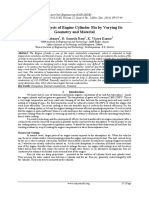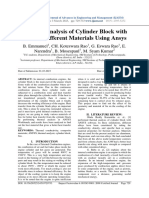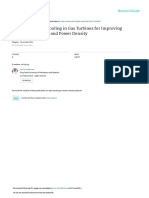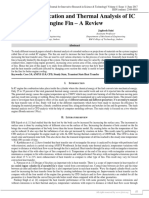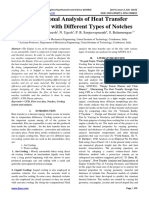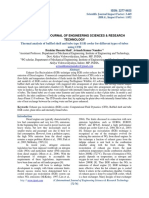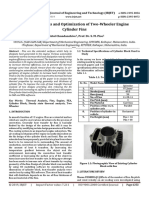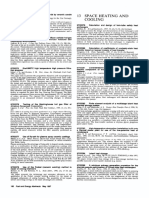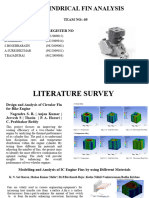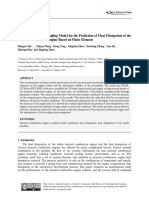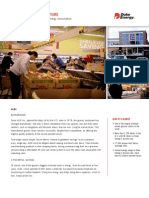Konveksi 03 OK
Konveksi 03 OK
Uploaded by
benhuseinnCopyright:
Available Formats
Konveksi 03 OK
Konveksi 03 OK
Uploaded by
benhuseinnOriginal Description:
Copyright
Available Formats
Share this document
Did you find this document useful?
Is this content inappropriate?
Copyright:
Available Formats
Konveksi 03 OK
Konveksi 03 OK
Uploaded by
benhuseinnCopyright:
Available Formats
Research Journal of Engineering Sciences ___________________________________________ ISSN 2278 9472
Vol. 1(2), 32-40, August (2012) Res. J. Engineering Sci.
Heat Transfer Augmentation of Air Cooled Internal Combustion Engine
Using Fins through Numerical Techniques
Mishra A.K., Nawal S. and Thundil Karuppa Raj R.
School of Mechanical and Building Sciences, VIT University, Vellore 632 014, Tamil Nadu, INDIA
Available online at: www.isca.in
Received 23rd July 2012, revised 3rd August 2012, accepted 21st August 2012
Abstract
Fins are basically mechanical structures which are used to cool various structures via the process of convection. Most part
of their design is basically limited by the design of the system. But still certain parameters and geometry could be modified to
better heat transfer. In most of the cases simple fin geometry is preferred such as rectangular fins and circular fins. Many
experimental works has been done to improve the heat release of the internal combustion engine cylinder and fin efficiency.
A numerical investigation has been carried for a finned metal cylinder using CFD and is validated against the experiments
carried out. A transient numerical analysis is carried out with wall cylinder temperature of 423 K initially and the heat
release from the cylinder is analyzed for zero wind velocity. The heat release from the cylinder which is calculated
numerically is validated with the experimental results. In the present paper an effort is made to study the effect of fin
parameters on fin array performance which includes variation in pitch and fin material. In addition, the current paper
considers the effect of air flow velocity on different fin pitch. With the help of the available numerical results, the design of
the internal combustion engine cooling fins can be altered for better efficiency.
Keywords: Heat transfer, extended surfaces, rectangular fins, grid generation, engine block.
Introduction and the temperature inside the cylinder is measured to determine
the heat release from the cylinder6. The cooling of motor cycle
An air cooled motorbike engine dissipates waste heat from the engines using extended fins were carried out experinetally7,8.
cylinder through the cooling fins to the cooling air flow created
by the relative motion of moving motorbikes. The cooling Two and three-dimensional decoupled and conjugate heat
system is an important engine subsystem. The air cooling transfer analysis has been done with commercially available
mechanism of the engine is mostly dependent on the fin design computational fluid dynamics (CFD) codes9. Problems of fluid
of the cylinder head and block. It also depends on the velocity and heat flow are governed by governing equations in the form
of the vehicle and the ambient temperature. The conduction heat of partial differential equations. In the present study, the
transfer from inner wall to fin surface is given as1: numerical results obtained by ANSYS FLUENT 12.1 CFD code
q = k (Tw Tfin) (1) is validated by the experiments performed on internal
The convection heat transfer from fin surface to atmosphere air combustion engine cylinder using aluminum fin in the thermal
by free and forced air is given as1: laboratory using thermocouples fitted on the surface of the fins.
q = hf (Tfin T air) (2)
In order to enhance the cooling of cylinder a parametric study is
This heat transfer from the fin is influenced by many fixed and carried out by varying the fin material with different thermal
variable constraints such as fin array, fluid flow velocity, fin conductivity values. Solutions have been obtained for different
geometry; shape and material etc. Many experimental methods materials like aluminum, cast iron and copper. The heat transfer
are available in literature to analyze the effect of these factors predominantly varies with air speeds and fin separation2. The fin
on the heat transfer rate. Thornhill and May presented results for spacing also influences the body mass and thermal limits of a
an experimental investigation in the cooling of finned metal fin array9. A study has been done for different fin spacing by
cylinders2,3. The effect of cooling of internal combustion engine keeping the wall height same and changing the number of fins.
cylinder in free air is studied4. An analysis for pitch 7mm, 10mm and 14mm has been carried.
The current paper represents an attempt to stimulate the The flow around the fin profile has been solved at different air
parametric study of fin heat transfer on the air cooled engine flow velocities from 20 m/s to 80 m/s. The effect of turbo-
using CFD codes. The experimental equation of the fin surface charging10 is also to be considered for complete analyses and the
heat transfer coefficient using an aluminum cylinder at the air relationship between the thermodynamic properties11 should be
velocity from 7.2 to 72 km/h was derived out and found to vary established. The study of trends observed for temperature
for different array5. In another experimental study, the effect of measurements and heat transfer coefficient have been included
varying the fin slit widths and slit setting positions, was tested in this paper. The analysis has been carried out in four stages.
International Science Congress Association 32
Research Journal of Engineering Sciences________________________________________________________ ISSN 2278 9472
Vol. 1(2), 32-40, August (2012) Res. J. Engineering Sci.
Material and Methods due to natural convection. Solution initialization was done at
303 K for all zones. Oil domain was patched to a temperature of
Experimental Set up and Measurement Techniques: The
423 K.
experimental setup has been shown in figure 1. Figure 2 shows
the experimental cylinder along with thermocouple position in
the cylinder and in the fin surface. The cylinder was made up of
cast iron and has a fitted cap. The volume of the hollow portion
of the experimental cylinder is 300 cm3. Fin was made of an
aluminum alloy (JIS A6010). The fins were fitted tightly in the
cylinder. Heat storage liquid (SAE 40 oil) of 300 cm3 was used
to fill the cylinder in order to maintain uniform temperature in
the cylinder. An induction heater with electrical power of 400
W was used to heat the oil to 150C. J type thermocouples were
inserted into the cylinder and fin to measure the temperature.
The heat storage liquid was heated and is poured into the
cylinder and the cap is placed above the cylinder. The Figure-1
temperature of the heat storage liquid was decreased by cooling Experimental cylinder with fins
at room temperature. The heat release from the cylinder was
obtained by multiplying the heat capacity of the heat storage
5
liquid by the difference between 150C and the temperature
after every 10 seconds at zero air velocity. The experiments 4
were carried out at an ambient temperature of 33C.
Modeling and Grid Generation: The cylinder, fin, air domain
and oil are modeled using ICEM-CFD. The dimensions of 3 2 1
cylinder and fins are exactly the same as that of the
experimental setup. The whole assembly is splitted into 3
domains: i. Solid domain: The solid domain consists of the fin
and cylinder. ii. Fluid domain I (SAE-40 oil): SAE-40 oil is 6
placed inside the cylinder as the heat source. iii. Fluid domain II 7
(Air): The surrounding domain is kept as air domain as
surrounding air exists.
Figure-2
The 3-D model geometry is imported in ICEM-CFD meshing Placement of thermocouple on the fins and cylinder
software for mesh generation. The domains are defined here and
are classified as above three domains. Fluid solid interfaces are Validation Results: It is observed from the CFD result that it
given the title FLSO and SOSO is used for solid-solid takes 150 seconds for the oil domain to reach the temperature
interfaces. The interfaces between air domain, cylinder and 339 K from 423 K. The temperature of air, cylinder and fins
SAE-40 oil are defined. Figure 3 shows the mesh of the fluid oil which are at ambient temperature is also increased by 26 K
and the finned cylinder. The meshing of rectangular air domain which confirms the heat transfer physics.
is done after inserting the geometry files of cylinder and fins to
avoid mesh inside these regions. The experimental results show that the value of heat release by
the oil through cylinder and fin is about 23.8 W. The heat
Solver Setup in ANSYS fluent: The flow around the finned release from the cylinder was obtained by multiplying the heat
cylinder has been solved at zero wind velocity. The mesh capacity of the heat storage liquid by the formula:
interfaces has been created in ANSYS fluent. The temperature Heat release, Q = mcpT
of the entering air was chosen to be 303 K. Outlet phase was
given fixed pressure conditions of 101.325 kPa representing Where, m = mass of the heat storage liquid, in Kg, cp= specific
atmospheric pressure. All the other faces of the air domain are heat capacity of SAE-40 oil, in J/kg/K, T= change in
given the wall boundary conditions. The solver was selected as temperature after 10 seconds, in K.
transient with gravity of 9.8m/s2 to consider buoyancy effects
International Science Congress Association 33
Research Journal of Engineering Sciences________________________________________________________ ISSN 2278 9472
Vol. 1(2), 32-40, August (2012) Res. J. Engineering Sci.
Thus the numerical result by CFD analysis is calculated and the shows the plot of heat release from the oil which is calculated
temperature of the fin for the first 100 seconds is plotted along after every 10 seconds. From the plot it can be inferred that the
with the experimental readings. Figure 4 shows the temperature experimental and numerical results show the same variation
at fin surface of numerical and experimental analysis, which is with deviation being less than +4%.
measured at a distance of 25 mm from cylinder surface. Figure 5
Figure-3
Meshed model of Cylinder, Oil domain and Fin
60
50
Temperature( C)
40
30 Numerical result
20 Experimental result
10
0
10 20 30 40 50 60 70 80 90 100
Time (s)
Figure-4
Time vs. Temperature plot for Numerical and Experimental Results
250
200
Heat release (W)
150
Heat release from numerical
100 study
50 Heat release from experimental
study
0
10 20 30 40 50 60 70 80 90 100
Time (s)
Figure-5
Heat Released vs. Time plot for Numerical & Experimental Study
International Science Congress Association 34
Research Journal of Engineering Sciences________________________________________________________ ISSN 2278 9472
Vol. 1(2), 32-40, August (2012) Res. J. Engineering Sci.
Results and Discussion been shown in figure 10. Different fin pitches are compared on
the basis of net heat dissipated at fin tip by all the fins in model.
Effect of Fin Material: To analyze the effect of material The surface heat transfer coefficient is multiplied by the area of
properties, copper, aluminum and cast iron were considered for one fin and number of fins in every fin geometry. The maximum
the best heat dissipation considering both the conduction and value of heat transfer is obtained for pitch of 10 mm. Figure 11
convection heat transfer parameters. Three numerical models shows the contour of heat transfer through 10 mm fin pitch
with different fin materials (copper, aluminum and cast iron) geometry at a velocity of 60 kmph.
and same cylinder material (cast iron) were simulated under
same operating conditions i.e. constant temperature of cylinder Effect of Velocity of Air: To examine whether the performance
inner wall at 150oC and wind velocity of 60 Km/hr. Figure 6
of different fin pitches varies with wind velocity, simulation are
shows the temperature profile on the copper fin surface. The
temperature contours for cast iron fin is shown in figure 7. As carried out for all the different pin pitches for different air
inferred from the figure the temperature is more distributed on velocity. Meshed model for air domain and fins were created
the copper fin, showing greater area of heat transfer. and shown in figure 12. The numerical analysis is carried out for
different velocities from 20 to 80 kmph. The velocity is given in
Figure 8 shows the variation of coefficient of heat transfer with positive x direction. Apart from inlet and pressure outlet all
change in fin material at fin tip. Under steady-state conditions, surfaces of air domain are specified as wall condition. Figure 13
copper fin has the maximum surface heat transfer coefficient at
shows the contour of heat transfer through 10 mm pitch
fin tip. Aluminum fin is marginally below the copper fin in
terms of surface heat transfer co-efficient and cast iron fin has geometry at a velocity of 20 kmph. The temperature contour of
the lowest value of co-efficient. same geometry at 80 kmph is shown in figure 14. The thermal
boundary layer can be easily observed between fins in the
Effect of Fin Pitch: Three different fin pitches of 7 mm, 10 mm figures. The region between the fins is hotter for 20 kmph in
and 14 mm have been analyzed for internal combustion engine comparison to 80 kmph, showing less heat transfer at lower
cylinder with 80 mm length. The pitches have been measured
wind velocity.
from fin surfaces. The number of fin varies with respect to the
change in the fin pitch. The number of fins is 6 for a fin pitch of
7 mm and it is 5 for a fin pitch of 10 mm. The heat transfer coefficient of different fin array is plotted
against variable air velocity in figure 15. The results show that
Figure 9 show the meshed model of 6 fins having a spacing of 7 the performance of fin model increases with wind velocity but
mm. The different fin pitch models were simulated at four the gradient decreases as wind velocity increases from 60 to 80
different air velocities (20, 40, 60 and 80 Kmph). Results have kmh.
Figure-6
Temperature Contour plot of Copper fins
International Science Congress Association 35
Research Journal of Engineering Sciences________________________________________________________ ISSN 2278 9472
Vol. 1(2), 32-40, August (2012) Res. J. Engineering Sci.
Figure-7
Temperature Contour plot of cast iron fins
Figure-8
Meshed model of 6 fins with 7mm pitch
International Science Congress Association 36
Research Journal of Engineering Sciences________________________________________________________ ISSN 2278 9472
Vol. 1(2), 32-40, August (2012) Res. J. Engineering Sci.
Figure-9
Boundary Layer plot of 5 fins with 10mm pitch at 60Kmph
Figure-10
Meshed model with Air Domain, Cylinder & Fins
International Science Congress Association 37
Research Journal of Engineering Sciences________________________________________________________ ISSN 2278 9472
Vol. 1(2), 32-40, August (2012) Res. J. Engineering Sci.
Figure-11
Boundary Layer plot of 5 fins at 10mm pitch at 20 Kmph
Figure-12
Boundary Layer plot of 5 fins at 10mm pitch at 80 Kmph
International Science Congress Association 38
Research Journal of Engineering Sciences________________________________________________________ ISSN 2278 9472
Vol. 1(2), 32-40, August (2012) Res. J. Engineering Sci.
78
Surface heat transfer co- 76
efficient at fin tip
74
(W/m^2*K)
72
70
68
66
64
Aluminium Copper Cast Iron
Figure-13
Plot of Heat Transfer for different materials
0.7
Surface heat transfer coefficient
0.6
at fin tip for all fins (W/K)
0.5
0.4
Pitch-7mm
0.3
0.2 Pitch-10mm
0.1 Pitch-14mm
0
20 40 60 80
Velocity (Km/hr)
Figure-14
Plot of Heat dissipated at fin tip vs. Velocity for different fin pitches
0.7
Surface heat transfer coefficient
0.6
at fin tip for all fins (W/K)
0.5
0.4 Velocity - 20 Kmh
0.3 Velocity - 40 Kmh
0.2 Velocity - 60 Kmh
0.1 Velocity - 80 Kmh
0
5 7 9 11 13 15
Fin Pitch (mm)
Figure-15
Heat dissipated by fins at tip at different velocities
International Science Congress Association 39
Research Journal of Engineering Sciences________________________________________________________ ISSN 2278 9472
Vol. 1(2), 32-40, August (2012) Res. J. Engineering Sci.
Conclusion Harley-Davidson Motor Co. Experimental Investigation
into the Temperature and Heat Transfer Distribution
For a given thermal load, the fin material and fin array around Air-Cooled Cylinders SAE paper 2006-32-0039 /
parameters could be optimized in a better way by numerical 20066539 (2006)
simulation methods. CFD could be used to determine optimal
values of fin parameters before actual design. To increase the 4. Thornhill D. and May A., An Experimental Investigation
cylinder cooling, the cylinder should have a greater number of into the Cooling of Finned Metal Cylinders in a free Air
fins. However, the cylinder cooling may decrease with an Stream, SAE Paper 1999-01-3307 (1999)
increased number of fins and too narrow a fin pitch. The is 5. Gibson H., The Air Cooling of Petrol Engines,
because the air could not flow well between the fins, thus the Proceedings of the Institute of Automobile Engineers,
overlapping of thermal boundary layers occurs at the upper and Vol.XIV, 243-275 (1920)
lower fin surfaces.
6. Biermann E. and Pinkel B., Heat Transfer from Finned
Metal Cylinders in an Air Stream, NACA Report No. 488
The study reveals that the optimized fin material with the
(1935)
greatest effective cooling is copper, the effective heat transfer
coefficient is found to be more for a pitch of 10mm and this 7. Masao Yoshida, Soichi Ishihara, Yoshio Murakami, Kohei
optimized fin array parameters is helpful in improving the Nakashima and Masago Yamamoto, Air-Cooling Effects
efficiency of the engine. of Fins on Motorcycle Engine, JSME International
Journal, Series B, 49(3), (2006)
Acknowledgement 8. Zakhirhusen, Memon K., Sundararajan T.,
The authors wish to thank Vellore Institute of Technology Lakshminarasimhan V., Babu Y.R. and Harne Vinay,
University, Vellore for providing the facilities necessary to Parametric study of finned heat transfer for Air Cooled
carry out the experimental and numerical works. The authors Motorcycle Engine, SAE Paper, 2005-26-361, (2005)
would also wish to thank the supporting staffs for their support. 9. Zakirhusen, Memon K. and Sundararajan T., Indian
Institute of Technology Madras, V. Lakshminarasimhan,
References Y.R. Babu and Vinay Harne, TVS Motor Company
Limited, Simulation and Experimental Evaluation of Air
1. Challen B., A textbook on Diesel engine reference book, Cooling for Motorcycle Engine, 2006-32-0099 / 20066599
SAE (1999) (2006)
2. Thornhill D., Graham A., Cunningham G., Troxier P. and 10. Pathak Sunil, Turbo charging and oil techniques in light
Meyer R., Experimental Investigation into the Free Air- motor vehicles, Res.J. Recent Sci, 1(1), 60-65 (2012)
Cooling of Air-Cooled Cylinders, SAE Paper 2003-32-
0034, (2003) 11. Dev Nikhil, Attri Rajesh, Mittal Vijay, Kumar Sandeep,
Mohit, Satyapal, Kumar pardeep, Thermodynamic analysis
3. Thornhill D., Stewart A. and Cuningham G., The Queens of a combined heat and power system, Res.J. Recent Sci,
University of Belfast Troxler P., Meyer R. and Price B. 1(3), 76-79 (2012)
International Science Congress Association 40
You might also like
- Presentation On Warehouse ManagementDocument22 pagesPresentation On Warehouse ManagementHarsh Ulhas Dave75% (4)
- Plumbing Method StatementDocument6 pagesPlumbing Method StatementShrikant BudholiaNo ratings yet
- AVR254, AVR354, AVR255, AVR355-hk2008-03rev1Document3 pagesAVR254, AVR354, AVR255, AVR355-hk2008-03rev1Steve Alexander100% (3)
- BrasiliaDocument10 pagesBrasiliaDamian Plouganou100% (1)
- 6.ISCA-RJRS-2012-141 DoneDocument6 pages6.ISCA-RJRS-2012-141 DoneAanand Rishabh DagaNo ratings yet
- Air Cooling Effect of Fins in MotorcycleDocument7 pagesAir Cooling Effect of Fins in Motorcyclestorage spaceNo ratings yet
- Sai Chaitanya PDFDocument8 pagesSai Chaitanya PDFasdfNo ratings yet
- CFD Analysis of An IC Engine With and Without GrooveDocument12 pagesCFD Analysis of An IC Engine With and Without GrooveIJRASETPublicationsNo ratings yet
- Design of I.C.Engine Air Cooling Fins Using Fea AnalysisDocument13 pagesDesign of I.C.Engine Air Cooling Fins Using Fea Analysisijire publicationNo ratings yet
- Thermal Analysis of Cylinder Block With Fins For Different Materials Using AnsysDocument5 pagesThermal Analysis of Cylinder Block With Fins For Different Materials Using Ansysarjunguttula11No ratings yet
- Flow Analysis of Gas Turbine Blade For Optimum CoolingDocument8 pagesFlow Analysis of Gas Turbine Blade For Optimum CoolingijsretNo ratings yet
- A Research On Analysis of Diesel Engine Cooling SystemDocument10 pagesA Research On Analysis of Diesel Engine Cooling SystemAman PokharanaNo ratings yet
- Design Engineering: Design and Thermal Analysis of Ic Engine Fins With Different Cross-Sectional FinsDocument12 pagesDesign Engineering: Design and Thermal Analysis of Ic Engine Fins With Different Cross-Sectional FinsVinay LuckiíNo ratings yet
- Design Analysis of Cooling Fins For Two Wheeler Using ANSYS: Chinnu - Samy80@yahoo - Co.inDocument6 pagesDesign Analysis of Cooling Fins For Two Wheeler Using ANSYS: Chinnu - Samy80@yahoo - Co.inFilip SkultetyNo ratings yet
- Heat SinkDocument14 pagesHeat SinkSafalsha BabuNo ratings yet
- NaveenDocument15 pagesNaveenNaveenprakashNo ratings yet
- Jet Impingement Cooling in Gas Turbines For Improving Thermal Efficiency and Power DensityDocument21 pagesJet Impingement Cooling in Gas Turbines For Improving Thermal Efficiency and Power DensityDileep ElangovanNo ratings yet
- Turbine Blade Cooling by Air Using Different Methods: September 2011Document23 pagesTurbine Blade Cooling by Air Using Different Methods: September 2011Badr BouananeNo ratings yet
- 1 s2.0 S2214157X1830128X Main PDFDocument13 pages1 s2.0 S2214157X1830128X Main PDFDonny SetyaNo ratings yet
- CFD Simulation and Heat Transfer Analysis of Automobile Radiator Using Helical TubesDocument12 pagesCFD Simulation and Heat Transfer Analysis of Automobile Radiator Using Helical TubesAleksandar PasicNo ratings yet
- CFD Simulation and Heat Transfer Analysis of A Radiator With Helical TubesDocument4 pagesCFD Simulation and Heat Transfer Analysis of A Radiator With Helical TubespugazhNo ratings yet
- CSL - CSL 202103 0024Document10 pagesCSL - CSL 202103 0024Muhammad SaqlainNo ratings yet
- Wiryanta 2018 J. Phys. Conf. Ser. 953 012060Document8 pagesWiryanta 2018 J. Phys. Conf. Ser. 953 012060vinodNo ratings yet
- Thermal Analysis of Engine BlockDocument6 pagesThermal Analysis of Engine BlockEditor IJTSRDNo ratings yet
- Steady and Transient Analysis of Engine Cylinder Head With Fins at 3000C and 5000CDocument11 pagesSteady and Transient Analysis of Engine Cylinder Head With Fins at 3000C and 5000CIJRASETPublicationsNo ratings yet
- Turbine Blade Cooling by Air Using Different MethodsDocument22 pagesTurbine Blade Cooling by Air Using Different MethodsclaudiomctNo ratings yet
- Simplified Numerical Model For A Flat Continuous Triangle Fins Air Cooled Heat Exchanger Using A Step by Step TechniqueDocument23 pagesSimplified Numerical Model For A Flat Continuous Triangle Fins Air Cooled Heat Exchanger Using A Step by Step TechniquemunkkkkNo ratings yet
- CFD Analysis of A Gas Turbine Blade Cooling in The Presence of HolesDocument11 pagesCFD Analysis of A Gas Turbine Blade Cooling in The Presence of HolesShivam KumarNo ratings yet
- A Conjugate Heat Transfer Analysis of A Hermetic RDocument11 pagesA Conjugate Heat Transfer Analysis of A Hermetic RMohammed Naim UddinNo ratings yet
- Design Modification and Thermal Analysis of IC Engine Fin - A ReviewDocument4 pagesDesign Modification and Thermal Analysis of IC Engine Fin - A ReviewIJIRSTNo ratings yet
- Computational Analysis of Heat Transfer Through FinsDocument9 pagesComputational Analysis of Heat Transfer Through FinsIJAERS JOURNALNo ratings yet
- 2013-J C Han GT Heat Transfer ReviewDocument15 pages2013-J C Han GT Heat Transfer ReviewSsheshan PugazhendhiNo ratings yet
- CFD Simulation and Heat Transfer Analysis of Automobile Radiator Using Helical TubesDocument12 pagesCFD Simulation and Heat Transfer Analysis of Automobile Radiator Using Helical TubesRamesh TNo ratings yet
- Thermal Analysis of Baffled Shell and Tu PDFDocument5 pagesThermal Analysis of Baffled Shell and Tu PDFPranav MishraNo ratings yet
- Heat Transfer Modeling of A Diesel EngineDocument34 pagesHeat Transfer Modeling of A Diesel EngineAbdullah OmerNo ratings yet
- Investigating The Malfunction of A Hydro-Generator'S Cooling-SystemDocument4 pagesInvestigating The Malfunction of A Hydro-Generator'S Cooling-SystemWalter JosephNo ratings yet
- Design and CFD Analysis of Combustion Chamber in IDocument10 pagesDesign and CFD Analysis of Combustion Chamber in IRuvimboNo ratings yet
- Hot BoxDocument5 pagesHot Boxsv27No ratings yet
- Improvement of New Fin Design For Automotive Water Cooling SystemDocument8 pagesImprovement of New Fin Design For Automotive Water Cooling SystemMurali KrishnaNo ratings yet
- Heat Transfer Modeling of A Diesel EngineDocument34 pagesHeat Transfer Modeling of A Diesel EngineMiltosNo ratings yet
- Novel Computational Design For Designing (1) - 1Document22 pagesNovel Computational Design For Designing (1) - 1ENVERNo ratings yet
- 3109 5142 1 PB PDFDocument11 pages3109 5142 1 PB PDFMuhammad Haroon100% (1)
- Case Studies in Thermal Engineering: C.Q. Su, W.S. Wang, X. Liu, Y.D. DengDocument7 pagesCase Studies in Thermal Engineering: C.Q. Su, W.S. Wang, X. Liu, Y.D. DengAbhishek jNo ratings yet
- Thermal Analysis and Optimization of Two-Wheeler Engine Cylinder FinsDocument8 pagesThermal Analysis and Optimization of Two-Wheeler Engine Cylinder FinsSYED KHAJA nizam uddinNo ratings yet
- Thermal Performance of HAVC SystemDocument9 pagesThermal Performance of HAVC Systemhani azizNo ratings yet
- 1 s2.0 S2214157X22003835 MainDocument17 pages1 s2.0 S2214157X22003835 MainMELQUI MELQUISIDEC RODRIGUEZ VACANo ratings yet
- Thermal Analysis On Different Exhaust Valve MaterialsDocument7 pagesThermal Analysis On Different Exhaust Valve Materialsalmas kurniaNo ratings yet
- Thermodynamic Simulation of Exhaust Gas Recirculation Coolers Used On Diesels Based On Finite Element MethodDocument5 pagesThermodynamic Simulation of Exhaust Gas Recirculation Coolers Used On Diesels Based On Finite Element MethodPranav MishraNo ratings yet
- 1 s2.0 S0140670197881945 MainDocument1 page1 s2.0 S0140670197881945 MainTomas ZadravecNo ratings yet
- CFD Analysis of An Elliptical Pin Fin Heat Sink Using Ansys Fluent v12.1Document8 pagesCFD Analysis of An Elliptical Pin Fin Heat Sink Using Ansys Fluent v12.1Kelsey RyanNo ratings yet
- Bike Cylindrical Fin AnalysisDocument11 pagesBike Cylindrical Fin AnalysisLal PrasathNo ratings yet
- TSP Ee 17273Document14 pagesTSP Ee 17273MANFOUMBINo ratings yet
- Ijte 05 01 005Document11 pagesIjte 05 01 005toancaocapa31No ratings yet
- Design and Performance Analysis of Automotive Radiator Using Computational Fluid DynamicsDocument6 pagesDesign and Performance Analysis of Automotive Radiator Using Computational Fluid DynamicsJuan Sebastian Ramirez MartinezNo ratings yet
- Icme05 FL 24Document5 pagesIcme05 FL 24gauravglittersNo ratings yet
- EES Volume 5 Issue 1 Pages 71-83Document13 pagesEES Volume 5 Issue 1 Pages 71-83armin heidariNo ratings yet
- Conjugate Calculation of A Film-Cooled Blade For Improvement of The Leading Edge Cooling ConfigurationDocument9 pagesConjugate Calculation of A Film-Cooled Blade For Improvement of The Leading Edge Cooling ConfigurationVibhanshu VermaNo ratings yet
- Calculation of Stirling EngineDocument10 pagesCalculation of Stirling EngineShafiq Mahadi0% (1)
- Experiments and Simulations On Heat Exchangers in Thermoelectric Generator For Automotive ApplicationDocument7 pagesExperiments and Simulations On Heat Exchangers in Thermoelectric Generator For Automotive ApplicationHimel BaruaNo ratings yet
- Project-II November, 2017: Chapter-2 Literature ReviewDocument5 pagesProject-II November, 2017: Chapter-2 Literature ReviewAkshat SharmaNo ratings yet
- Design and Development of Waste Heat Recovery System For Domestic RefrigeratorDocument5 pagesDesign and Development of Waste Heat Recovery System For Domestic RefrigeratorAsifNo ratings yet
- A Simplified Model For The Prediction of The Thermal Performance For Cross Flow Air Cooled Heat Exchangers With A New Air Side Thermal CorrelationDocument32 pagesA Simplified Model For The Prediction of The Thermal Performance For Cross Flow Air Cooled Heat Exchangers With A New Air Side Thermal CorrelationGuillaumeNo ratings yet
- Geothermal Energy: Sustainable Heating and Cooling Using the GroundFrom EverandGeothermal Energy: Sustainable Heating and Cooling Using the GroundNo ratings yet
- Global Milling Annual 2014Document56 pagesGlobal Milling Annual 2014Global MillingNo ratings yet
- You'Re Using ChatGPT Wrong! Here's How To Be Ahead of 99% of ChatGPT Users - by The PyCoach - Mar, 2023 - Artificial CornerDocument1 pageYou'Re Using ChatGPT Wrong! Here's How To Be Ahead of 99% of ChatGPT Users - by The PyCoach - Mar, 2023 - Artificial Corneruday madaanNo ratings yet
- Sans SerifDocument11 pagesSans SerifAdela ZejnilovicNo ratings yet
- Z.E.T.S.S. Payment Form: (In Black Ink)Document1 pageZ.E.T.S.S. Payment Form: (In Black Ink)Samson MaqwazaNo ratings yet
- Sunmbo Bukoye Oladejo - 9158705127 - 20240406232518Document2 pagesSunmbo Bukoye Oladejo - 9158705127 - 20240406232518mr6522294No ratings yet
- File Application (Fachrul R. Sobari)Document9 pagesFile Application (Fachrul R. Sobari)sobariNo ratings yet
- Multiplex CommunicationDocument17 pagesMultiplex CommunicationlogammicNo ratings yet
- Chapter Two: Choice, Opportunity Costs and SpecializationDocument39 pagesChapter Two: Choice, Opportunity Costs and SpecializationMyra SinhaNo ratings yet
- Assignment 3 ICT (MOHAMAD AZWAN BIN MOHAMED G1819417)Document3 pagesAssignment 3 ICT (MOHAMAD AZWAN BIN MOHAMED G1819417)Azwan MohamadNo ratings yet
- Final ProjectDocument47 pagesFinal ProjectKshitij MishraNo ratings yet
- Armalite Arms 2012 CatalogDocument40 pagesArmalite Arms 2012 Catalogsergey62No ratings yet
- General Electric Company (Document5 pagesGeneral Electric Company (Malak ShararyNo ratings yet
- CLOT KPI Analysis Guideline (RJIL) - v1.0Document135 pagesCLOT KPI Analysis Guideline (RJIL) - v1.0shaikhNo ratings yet
- VoLTE MOS Improvement Kalasin - Khon Kaen - Ban Huai Sai - V1Document12 pagesVoLTE MOS Improvement Kalasin - Khon Kaen - Ban Huai Sai - V1Muhammad Basharat Ali AwanNo ratings yet
- PPM QBR TemplateDocument10 pagesPPM QBR Templatergrao85No ratings yet
- Research ProjectDocument39 pagesResearch ProjectRebeen Omar AliNo ratings yet
- Lab Sessional - SP2021Document3 pagesLab Sessional - SP2021Talha TufailNo ratings yet
- Phillips Disaster 1989Document24 pagesPhillips Disaster 1989ieja03100% (2)
- Barney Popsicle AssignmentDocument7 pagesBarney Popsicle AssignmentmissbellsstudentsNo ratings yet
- GuidelineDocument69 pagesGuidelineJayaletchumi MoorthyNo ratings yet
- FLNG Training Module 1.1 Introduction To FLNG Rev 1Document34 pagesFLNG Training Module 1.1 Introduction To FLNG Rev 1Jay Kanes100% (3)
- Aldi Case StudyDocument2 pagesAldi Case StudyMoaath AltousiNo ratings yet
- SamplingDocument8 pagesSamplingSreedhar BellaryNo ratings yet
- Mitsubishi Electric PAR-40MAA Installation Manual EngDocument32 pagesMitsubishi Electric PAR-40MAA Installation Manual Engjohny5No ratings yet
- Chessboard and Chess Piece Recognition With The Support of Neural NetworksDocument11 pagesChessboard and Chess Piece Recognition With The Support of Neural NetworksFrancesco RossetiNo ratings yet







